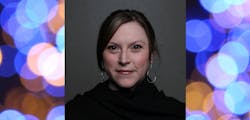You saw the headline. This isn’t a blog about smart lighting…but it is a blog about smart approaches to lighting backed by data.
Day 4 of the US Department of Energy (DOE) Lighting R&D Workshop reached across the divide of the “here and now” of lighting manufacturing and design implementation to the potential of what it can be going forward. And I found it pretty invigorating.
Concentrating here on the session titled “Data’s Role in the Future of Building Design and Operation,” speakers with computer programming, lighting design, and building systems experience described a compelling roadmap of lighting design, implementation, and monitoring that relies upon a combination of intelligent software tools, analysis, and human ingenuity to achieve smart, healthy, productive environments that utilize resources efficiently and provide a framework for the move toward zero energy.
Lighting design and engineering consultant Star Davis described engineering as the process of applying known solutions to unique problems; design as developing a unique solution to a known problem; and innovation as “the sweet spot” where the two processes meet.
How does that happen in a built environment, with so many architectural, operational, and behavioral factors involved? According to Leland Curtis, co-lead of computation design at architecture and planning firm SmithGroup, the future of design requires embracing new computer-based tools and leveraging data. He advised seeking out user-friendly visual scripting tools that can be utilized as building blocks by anyone in the design and implementation process, without a computer science background – particularly highlighting the Grasshopper visual programming language and interface for the Rhinoceros CAD application.
Davis concurred, saying that a focus on minutiae and “trivial tweaks” wastes time that could be spent on creative ideas that can’t be handled by algorithms. These perspectives hearken back to what Innovative Lighting Consultants’ Michael Kershner proposed during our own virtual event in September — that creating operational efficiency by applying data and automation would not only help to quantify project outcomes for clients but also would free up product developers, lighting designers, and consultants to expand to problem-solving approaches that go beyond replacing traditional light sources with LEDs that mimic the exact same form factors and perpetuate the advance toward a stagnated and commoditized LED and solid-state lighting (SSL) market.
Related article: Picture the future of SSL within the mirror world
Speaker Cindy Zhu of Prescriptive Data brought a holistic building operations viewpoint to the mix. The company engineered a technology-agnostic building operating system (OS), Nantum, to centralize, analyze, and manage all datapoints and functions in a building. She demonstrated how a seemingly overwhelming amount of disparate information can be distilled into various values in a central dashboard. In the “cockpit,” as Zhu called it, 3-D models and real-time floorplans enable live monitoring of occupancy and operations, notifying building engineers and facilities managers of opportunities for maintenance, improved efficiencies, and space optimization based on learning the building’s typical usage and functions over time. This is obviously a deep dive beyond lighting alone, but as Zhu noted, “siloes create complexity” for building engineers. Zooming out on this, it’s in the best interest of the entire project team to ensure the end result is functional and comfortable for the building occupants, as well as cost-effective and manageable for the end user responsible for the facility.
Look for more on the DOE workshop next week.
For up-to-the-minute LED and SSL updates, why not follow us on Twitter? You’ll find curated content and commentary, as well as information on industry events, webcasts, and surveys on our LinkedIn Company Page and our Facebook page.

Carrie Meadows | Editor-in-Chief, LEDs Magazine
Carrie Meadows has more than 20 years of experience in the publishing and media industry. She worked with the PennWell Technology Group for more than 17 years, having been part of the editorial staff at Solid State Technology, Microlithography World, Lightwave, Portable Design, CleanRooms, Laser Focus World, and Vision Systems Design before the group was acquired by current parent company Endeavor Business Media.
Meadows has received finalist recognition for LEDs Magazine in the FOLIO Eddie Awards, and has volunteered as a judge on several B2B editorial awards committees. She received a BA in English literature from Saint Anselm College, and earned thesis honors in the college's Geisel Library. Without the patience to sit down and write a book of her own, she has gladly undertaken the role of editor for the writings of friends and family.
Meadows enjoys living in the beautiful but sometimes unpredictable four seasons of the New England region, volunteering with an animal shelter, reading (of course), and walking with friends and extended "dog family" in her spare time.





